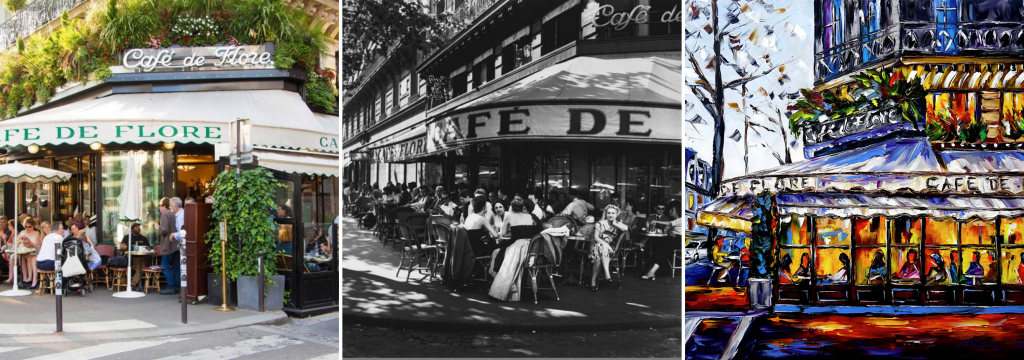Rendez-vous with History: Gastronomy’s legendary addresses in the 6th Arrondissement
- 12/12/2023
- In Paris
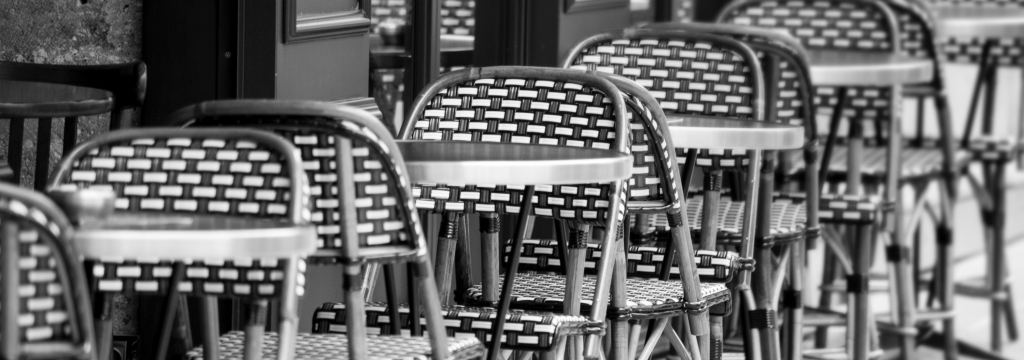
The history of Parisian terraces and restaurants
The history of Parisian restaurants is rich, fascinating, and dates back to the 18th century. The origin of the word “restaurant” is attributed to a Parisian entrepreneur who opened an establishment on Rue des Poulies and displayed a sign with the inscription “restaurant” to indicate that he served restorative broths believed to have healing virtues. During that time, inns often offered fixed meals, but this entrepreneur revolutionized the industry by providing à la carte dishes.
Have you noticed the multitude of terraces in Paris? The popularization of terraces in Parisian restaurants is closely linked to the social and cultural evolution of the city. In the 19th century, Paris was booming, with the transformation of old neighborhoods into grand boulevards thanks to Baron Haussmann. It was during this period that cafes and restaurants multiplied, and terraces became popular places. This growth can be attributed to several factors: Firstly, Parisians, lovers of social life, appreciated the opportunity to sit outdoors, enjoy the weather, and observe the bustling street activity. Terraces offered a friendly and relaxed atmosphere, allowing customers to meet their friends in an outdoor setting. Additionally, terraces were a means for restaurateurs to maximize their space. In a city where space is often limited, terraces provided a clever solution to accommodate more guests.
Today, Parisian terraces have become emblematic of Parisian culture, associated with the romantic idea of enjoying coffee or a meal outdoors while observing the world passing by. Some restaurants and cafes stand out with remarkably elegant décors. In this article, you will discover the fascinating stories of the greatest restaurants in Paris.
Focus on the restaurants that have left their mark on Paris’s 6th arrondissement
- Le Procope, the oldest restaurant in Paris
Located in the heart of the Latin Quarter of Paris, Le Procope is considered the city’s oldest restaurant. Its history dates back to 1686 when Francesco Procopio dei Coltelli, originally from Palermo, opened a café that would later become known as Le Procope. At the time, the place was frequented by intellectuals, writers, philosophers, and artists, making Le Procope an important cultural hub.
In its early days, Le Procope was more of a literary café than a restaurant. Enlightened minds such as Voltaire, Rousseau, Diderot, and others gathered to discuss new ideas and intellectual movements of the time. The café also served as a meeting place for Enlightenment thinkers, and many revolutionary projects were discussed within its walls.
Over the centuries, Le Procope evolved into a renowned restaurant, but it has preserved its historical atmosphere. The establishment witnessed many significant events in French history, including the Revolution of 1789, and survived through political and social changes, becoming an iconic place where history and gastronomy converge.
Today, Le Procope continues to welcome visitors from around the world, offering a unique experience that blends the charm of the past with delicious contemporary French cuisine. Its walls are adorned with historical memorabilia, making Le Procope not only a restaurant but also a living museum of Parisian history.
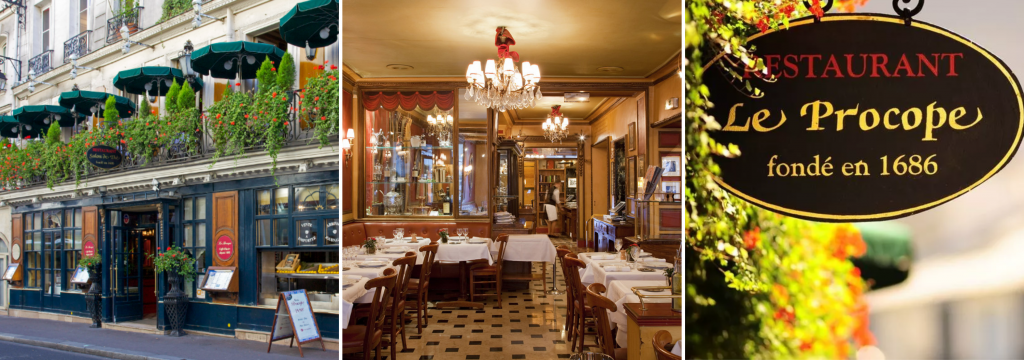
- La Pérouse, the restaurant for explorers and sailors
The restaurant La Pérouse, located on the banks of the Seine River in Paris, has a fascinating history that dates back to the 18th century. Founded in 1766, the establishment takes its name from the famous French explorer, Count de La Pérouse.
Initially, La Pérouse was an inn frequented by sailors, explorers, and adventurers of the time. Its location on the banks of the Seine made it a privileged spot for those embarking on expeditions or returning from distant journeys. Legend even has it that Napoleon Bonaparte visited the inn before departing for his exile on the island of Elba.
Over the years, La Pérouse became a popular meeting place for the Parisian high society. The restaurant underwent renovations in the 19th century and gained a notorious reputation for its romantic ambiance and sumptuous décor. The rooms are adorned with mirrors, precious woodwork, and elegant chandeliers.
The restaurant has had moments of glory throughout its history, hosting famous personalities and artists such as Victor Hugo, George Sand, and Gustave Flaubert. It has also survived periods of political change, preserving its charm and unique character.
Today, La Pérouse remains an iconic establishment on the Parisian gastronomic scene, celebrating its rich past while continuing to offer a unique culinary and cultural experience along the banks of the Seine.
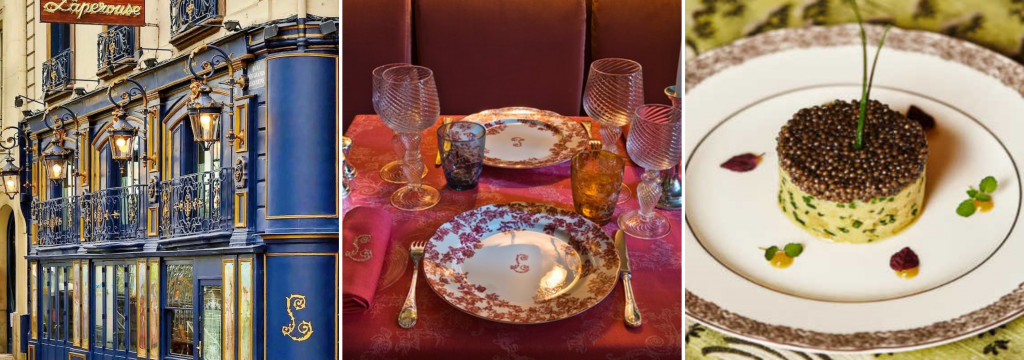
- The more recent story of chef Hélène Darroz and her restaurant Marsan
Known in the world of French gastronomy and admired by the general public, it is impossible not to be familiar with Hélène Darroze, a highly acclaimed Michelin-starred chef, whom Littré had the pleasure of hosting for one of its later seminars.
Coming from a family with roots in the culinary world, Hélène Darroze began her career in the culinary field and later won several awards, including 2 Michelin stars for her restaurants in Paris and London.
Her extreme professionalism and ability to hit the mark are evident every time she opens a new establishment. The concept of her restaurant Marsan is to offer signature dishes that represent the spirit of the establishment and its location on Rue d’Assas in the 6th arrondissement. The atmosphere adds a lot to this understated and elegant address where only the finest ingredients are presented: for example, blue lobster gently poached in Espelette pepper butter, grilled wagyu by the fireplace with a whole confit tomato stuffed with tomatoes, or the essential dessert: the baba soaked in Armagnac.
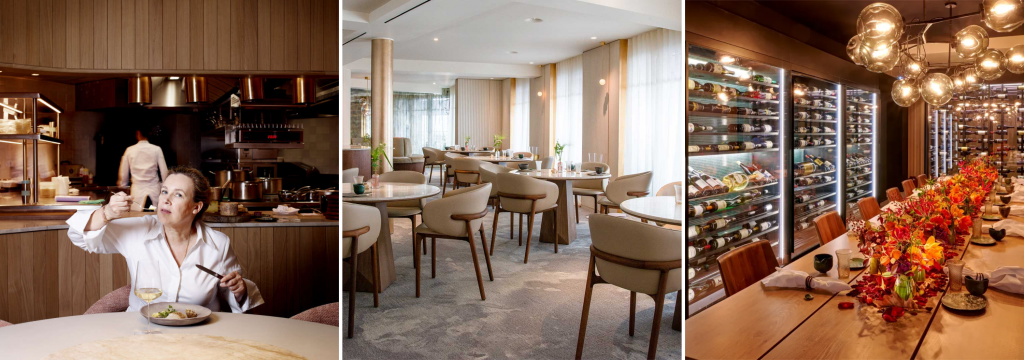
- Le Pont Traversé, a café with a bookshop feel
Near the Luxembourg Gardens and the Le Littré hotel, Le Pont Traversé, once a butcher shop and later a bookstore, takes its name from a collection of tales by Jean Paulhan.
After the closure of the butcher shop, the bookstore was founded by the writer and poet Marcel Béalu in 1949. However, in 2019, the bookstore closed its doors. Frédérique Jules then took on the task of transforming the space while preserving the original storefront and murals, classified as a historical monument, to make way for an entirely new, sleek café and a delicatessen, still under the name Le Pont Traversé. The facade is striking, as it still features sculpted beef heads and enamel plaques, a nod to the former butcher shop. The café is warm and inviting, adorned with ornaments and cement tiles that shine. Le Pont Traversé is a place of life, sharing, and exchange where one can have lunch, dinner, or enjoy a coffee or a drink on the terrace. On the shelves of Le Pont Traversé, you can also find homemade jams and spreads, chocolate, tea, coffee, and olive oil – perfect for taking home a souvenir of the capital.
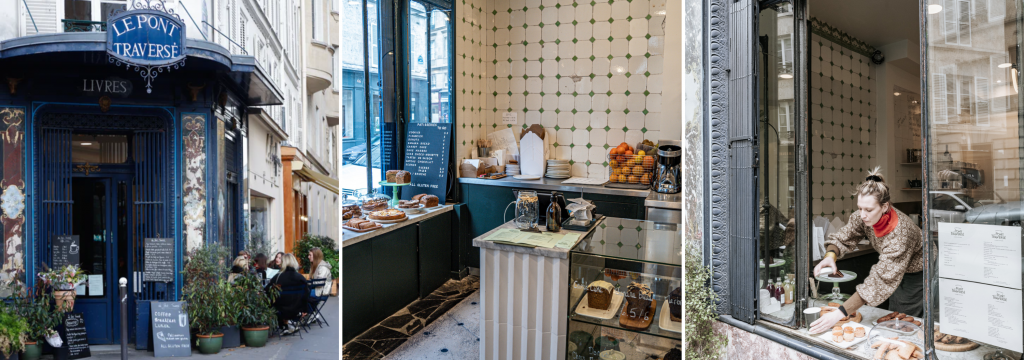
- Café de Flore, the café of the stars
Le Café de Flore is one of the iconic cafes near the Le Littré hotel, located in the Saint-Germain-des-Prés neighborhood. Founded in 1887, the cafe has been a meeting place for numerous intellectual, artistic, and literary figures over the decades.
In the early 20th century, Café de Flore was frequented by writers such as Guillaume Apollinaire, André Gide, and Paul Eluard. In the 1930s, it became the haunt of Jean-Paul Sartre and Simone de Beauvoir, who spent long hours there discussing philosophy and literature.
During World War II, Café de Flore was a meeting place for the Resistance. After the war, it continued to attract intellectuals and artists, becoming a symbol of intellectual and bohemian Paris. Later on, the cafe also witnessed the beginnings of many celebrities, including Pablo Picasso.
Today, Café de Flore retains its old-world charm and continues to attract visitors from around the world. It remains one of the most iconic cafes in Paris, associated with the cultural and literary history of the city. You can pay homage to the place by enjoying a croissant or a good espresso.
